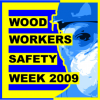 Warning: Unlike most others, there’s no blood involved in this safety tip.
Warning: Unlike most others, there’s no blood involved in this safety tip.
Executive Summary: When the going gets tough, STOP. There’s something wrong with:
- The tool you are using
- The way you are using it
- Your frame of mind.
Many of the safety tips we are seeing this week relate real life experiences. Here’s my confession. Back when I was learning how to effectively resaw long lumber with handtools, I did one trial cut using a simple, but sharp, Disston rip saw. I knew that the workholding setup was less than optimal and that I would need something better. I knew that this wasn’t the tool I ultimately wanted to use but had not yet built the much better frame saw. When the sawing got tougher than it should have been, I knew that I should stop and give up the test. Instead, I just ploughed on through, eager to see what that piece of wood looked like when sliced in that manner.
One of the oddities of rotator cuff injuries is that they don’t manifest immediately. They become apparent only when the injury, in this case a torn tendon under the anterior deltoid, is asked to do something that irritates the injury, such as reaching up to get something from a high shelf. It’s the coming down that goes “Zowie!” These sorts of injuries take months to heal, and this one is no exception. One can’t simply stop using a shoulder and wait. So, I’ve included some extra therapy to build muscle strength in the deltoids, and have continued on with life as usual, despite the rather frequent “Zowies!” After all, there’s a boat to be built!
Bottom line: When your sawing, or planing, or other handtool activity becomes difficult, STOP. Check your tools for sharpness. Optimize workholding. Diagnose why unusual force may be needed. Maybe all you need is a mental break and a fresh approach. Don’t just muscle your way through it. You could bear the consequences for months.
By the way, a comment about aging. I’ll become 65 this year. I’ve already noticed that nature starts taking things away from you as you age. Regular weight training is part of the way I fight that off, as is plenty of handtool work in my boatbuilding shop. Stretching and staying flexible is also part of that regimen. A few days ago I saw an entry on one of the woodworking forums where a guy said he wasn’t going to put a leg vise on his workbench because he doesn’t like bending down to adjust the vice. Making an assumption that he’s in his mid-life years, I’ve got news for him and others who think this way: Get use to bending and staying flexible, or by the time you retire and have more time for your hobby your body won’t be able to do it.
Excellent hand tool safety, and fitness reminders Bob, and your Fiddlehead is looking real good too! – Ron